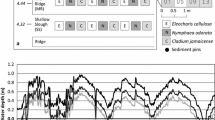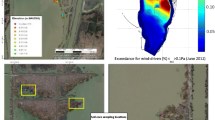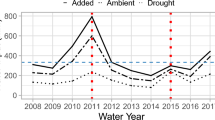Abstract
We analyzed soil water data from three sites with different soil textures in the shortgrass steppe of northeastern Colorado, USA. Our objective was to evaluate the relationship between the occurrence of plant functional types and the effect of soil texture on soil water availability. Soil water availability was greatest in the upper soil layers at all three sites, but the loamy sand site had significantly greater soil water availability than the sandy clay loam and sandy clay sites in wetter years at depths below 60 cm. Calculations of proportional water availability by layer using both field data and fifty-year soil water model simulations, showed that the sandy clay loam and sandy clay soils on average had greater water availability in layers 30 cm and above, but that the loamy sand had the greatest water availability in layers beneath this, particularly at 105 cm. This observation can be linked to the occurrence of a fine textured subsoil at this site. The textural pattern in the loamy sand profile effectively creates two water resources: a shallow pool accessible to all plants; and a deep pool accessible only to deep-rooted plants. This is offered as an explanation for the co-dominance of the two main plant functional types at the loamy sand site. At the other two sites, shallow-rooted shortgrass vegetation dominated, being more consistent with the general pattern for the area. Thus the patterns of vegetation structure at the three sites were consistent with the hypothesis. Aboveground net primary production data for the three sites, along with transpiration estimates from the model simulations, indicated that the additional water availability in the coarse textured soil was associated with higher overall plant productivity.
Nomenclature: Taxonomic nomenclature follows R. L. McGregor & T. M. Barkley (1986) Flora of the Great Plains. Great Plains Flora Association. University Press of Kansas, Lawrence.
Similar content being viewed by others
References
Archer, S. R. 1995. Tree-grass dynamics in a Prosopsis-thornscrub savanna parkland: Reconstructing the past and predicting the future. Ecoscience 2(1): 83-99.
Barnes, P. W. & Harrison, A. T. 1982. Species distribution and community organization in a Nebraska sandhills mixed prairie as influenced by plant/soil-water relationships. Oecologia 52: 192- 201.
Bouyoucos, G. J. 1962. Hydrometer method improved for making particle size analysis of soils. Agron. J. 54: 464-465.
Cosby, B. J., Hornberger, G. M., Clapp, R. B. & Ginn, T. R. 1984. A statistical exploration of the relationships of soil moisture characteristics to the physical properties of soils. Water Res. Res. 20(6): 682-690.
Crowe, E. A., Busacca, A. J., Reganold, J. P. & Zamora, B. J. 1994.
Vegetation zones and soil characteristics in vernal pools in the channeled scabland of Eastern Washington. Great Basin Natur. 54(3): 234-247.
Davis, S. D. & Mooney, H. A. 1985. Comparative water relations of adjacent California shrub and grassland communities. Oecologia 66: 522-529.
Davis, S. D. & Mooney, H. A. 1986. Water use patterns of four co-occurring chaparral shrubs. Oecologia 70: 172-177.
Ehleringer, J. R., Phillips, S. L., Schuster, W. S. F. & Sandquist, D. R. 1991. Differential utilization of summer rains by desert plants. Oecologia 88: 430-434.
Gitay, H. & Noble, I. R. 1997. What are functional types and how should we seek them? Pp. 3-19. In: Smith, T. M., Woodward, I. A. & Shugart H. H. (eds), Plant Functional Types. Cambridge University Press, Cambridge.
Kalman, R. E. 1960. A new approach to linear filtering and prediction problems. J. of Basic Eng. (Series D) 82: 35-45.
Key, L. J., Delph, L. F., Thompson, D. B. & Van Hoogenstyn, E. P. 1984. Edaphic factors and the perennial plant community of a Sonoran Desert bajada. Southwestern Naturalist 29(2): 211-222.
Knoop, W. T. & Walker, B. H. 1985. Interactions of woody and herbaceous vegetation in a southern African savanna. J. Ecology 83: 235-253.
Lane, D. 1995. Above-ground net primary production across a precipitation gradient in the central grassland region. M. S. Thesis. Department of Rangeland Ecosystem Science, Colorado State University.
Lauenroth, W. K. & Milchunas, D. G. 1991. Short-grass steppe. pp. 183-226. In: Coupland, R. T. (ed), Ecosystems of the World 8A. Natural Grasslands. Introduction and Western Hemisphere. Elsevier, Amsterdam.
Lauenroth, W. K. & Sala, O. E. 1992. Long term forage production of North American shortgrass steppe. Ecol. Appl. 2: 397-403.
Lauenroth, W. K. & Sims, P. L. 1976. Evapotranspiration from a shortgrass prairie subjected to water and nitrogen treatments. Water Res. Res. 12: 437-442.
Lauenroth, W. K., Urban, D. L., Coffin, D. P., Parton, W. J., Shugart, H. H., Kirchner, T. B. & Smith, T. M. 1993. Modeling vegeta tion structure - ecosystem process interactions across sites and ecosystems. Ecol. Modelling 67: 49-80.
Lee, C. A. 1990. The spatial distribution of roots for three plant lifeforms in the shortgrass steppe. M. S. Thesis. Department of Rangeland Ecosystem Science, Colorado State University
Lee, C. A. & Lauenroth, W. K. 1994. Spatial distribution of grass and shrub root systems in the shortgrass steppe. Am. Midland Nat. 137: 117-123.
Le Roux, X., Bariac, T. & Mariotti, A. 1995. Spatial partitioning of the soil water resource between grass and shrub components in a West African humid savanna. Oecologia 104: 147-155.
Liang, Y. M., Hazlett, D. L. & Lauenroth, W. K. 1989. Biomass dynamics and water use efficiencies of five plant communities in the shortgrass steppe. Oecologia 80: 148-153.
McAuliffe, J. R. 1994. Landscape evolution, soil formation, and ecological patterns and processes in Sonoran Desert bajadas. Ecol. Monog. 64(2): 111-148.
Milchunas, D. G., Lauenroth, W. K., Chapman, P. L. & Kazempour, M. K. 1989. Effects of grazing, topography, and precipitation on the structure of a semiarid grassland. Vegetatio 80: 11-23.
Noy-Meir, I. 1973. Desert ecosystems: environment and producers. Ann. Rev. Ecol. Syst. 4: 25-51.
Parker, K. C. 1991. Topography, substrate, and vegetation patterns in the northern Sonoran Desert. J. Biog. 18: 151-163.
Parton, W. J. 1978. Abiotic section of ELM. Pp. 31-53. In: Innis, G. S. (ed), Grassland Simulation Model. Ecological Studies 26. Springer-Verlag, New York.
Paruelo, J. M. & Sala, O. E. 1995. Water losses in the Patagonian steppe: a modeling approach. Ecology 76: 510-520.
Paruelo, J. M. & Lauenroth, W. K. 1996. Relative abundance of plant functional types in grasslands and shrublands of North America. Ecol. Appl. 6(4) 1212-1224.
Sala, O. E., Golluscio, R. A., Lauenroth, W. K. & Soriano, A. 1989. Resource partitioning between shrubs and grasses in the Patagonian Steppe. Oecologia 81: 501-505.
Sala, O. E. & Lauenroth, W. K. 1982. Small rainfall events, an ecological role in semiarid regions. Oecologia 53: 301-304.
Sala, O. E., Parton, W. J., Joyce, L. A. & Lauenroth, W. K. 1988. Primary production of the central grassland region of the United States. Ecology 69(1): 40-45.
Sala, O. E., Lauenroth, W. K., Parton & W. J. 1992. Long term soil water dynamics in the shortgrass steppe. Ecology 73: 1175-1181.
Sala, O. E., Lauenroth, W. K. & Golluscio, R. A. 1997. Plant functional types in temperate arid regions. Pp. 217-233. In: Smith, T. M., Woodward, I. A. & Shugart H. H. (eds), Plant Functional Types. Cambridge University, Cambridge.
Seghieri, J. 1995. Plant phenology in relation to water availability: herbaceous and woody species in the savannas of northern Cameroon. J. Tropical Ecol. 11: 237-254.
Sims, P. L., Singh, J. S. & Lauenroth, W. K. 1978. The structure and function of ten western North American grasslands I. Abiotic and vegetational characteristics. J. Ecol. 66: 251-285.
Soriano, A. & Sala, O. E. 1983. Ecological strategies in a Patagonian arid steppe. Vegetatio 56: 9-15.
Van Haveren, B. P. & Galbraith, A. F. 1971. Some hydrologic and physical properties of themajor soil types on the Pawnee intensive site. Technical Report # 115, IBP Grassland Biome.
Walker, B. H., Ludwig, D., Holling, C. S. & Peterman, R. M. 1981. Stability of semi-arid savanna grazing systems. J. Ecol. 69: 473- 498.
Walker, B. H. & Noy-Meir, I. 1982. Aspects of the stability and resilience of savanna ecosystems. Pp. 556-590. In: Huntley, B. J. & Walker, B. H. (eds), Ecology of Tropical Savannas. Springer-Verlag, Berlin.
Walter, H. 1979. Vegetation of the Earth. 2nd ed. Springer-Verlag, New York.
Weaver, J. E. 1958. Summary and interpretation of underground development in natural grassland communities. Ecol. Monog. 28(1): 55-78
West, N. E. 1988. Intermountain deserts, shrub steppes, and woodlands. Pp. 209-230. In: Barbour, M. G. & Billings, W. D. (eds), North American Terrestrial Vegetation. Cambridge University Press, New York.
Author information
Authors and Affiliations
Rights and permissions
About this article
Cite this article
Dodd, M.B., Lauenroth, W.K. The influence of soil texture on the soil water dynamics and vegetation structure of a shortgrass steppe ecosystem. Plant Ecology 133, 13–28 (1997). https://doi.org/10.1023/A:1009759421640
Issue Date:
DOI: https://doi.org/10.1023/A:1009759421640




